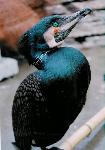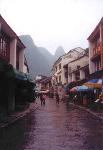- Getting around Lijiang. Dont stay in the Old Towns more than 2 days, there is nothing to do. KRISS Oct 9, 2013 05:46
- 2013 Beijing Temple Fair BENNYLAU Feb 26, 2013 03:29
- Malaysian traveling from KUL - LAX vis Shanghai PVG ZATI_DY Jan 3, 2013 20:15
The Green Hills of Yangshuo
- Views: 12262
- |Vote: 1 1
- |Add to Favorites
- |Recommend to Friends
Best Things Saved for Last
From the time we initially planned our journey in China, we decided to save the best place for last – so Guilin became our last stop in a 3-week tour that saw us travel from northern to southern China. When we arrived at Guilin airport, the humidity kissed our faces in a warm welcome, and gave such a relief to our winter-weary eyes -- for surrounding us was a lush, subtropical garden entirely different from the deadened landscapes we just escaped.
Guilin is famous for its limestone karst hills that – in sunshine or in silhouette -- rival the Great Wall as the signature representation of China. Their vistas have also been a source of inspiration to poets and painters throughout the centuries. With odd shapes that defy convention, the mist-wrapped hills of Guilin bring to mind the surreal, fantastical world of Dr. Seuss’ books.
The River Cruise from Guilin to Yangshuo
Like many visitors to Guilin, we opted for the river cruise to Yangshuo from Guilin along the Lijiang River, since the terminus town of Yangshuo is an ideal location from where to explore the karst hills. We rode a bus for a half-hour ride to the Zhujiang Pier (a half hour ride from Guilin), where crowds of tourists from numerous tour buses filed into boats. The docks somehow reminded of race cars at the Indy start line, and gave a much more commercialized image than I previously had of Guilin. As they started their blubbering motors, they took staggered positions down the wide Lijiang and then we were on our way.
Soon after we departed, our tour guide started giving a commentary about the surrounding area in such mind-numbingly loud Mandarin over the loudspeakers that it was ruining what I hoped would be a peaceful experience. I immediately put on my earplugs (that come in useful in situations like these) and was pleased to hear the tour guide’s voice quieten and allow me to finally enjoy the marvelous scenes outside. We sank back in our seats and gazed outside with a shared emotion, most dream-like in our contemplation of the emerald hills. Then, at the tour guide’s urging, we went outside to get a closer look at natural tableaus and sculptures like Nine-Horse Painted Hill, Five Tigers Catch a Goat Hill, and Frog Riding Turtle Hill.
As a light rain lacquered the deck and tapped my shoulder tips, I thought of the many paintings I had seen of these hills. In traditional paintings, Chinese fairies with ornate hairdos, big hairpins, and slender bodies travel upon clouds that usher them from mountaintop to mountaintop. Their long flowing garments – in pastel hues – billow gently behind them in the breezes. In this misty weather, it was easy to see how classical writers and painters could have easily imagined these ethereal creatures.
The Lijiang River and its mountains have a way of weaving a spell over their visitors. It has been said that when your heart sings, you know you’re in love – and this river made my heart sing. Guilin is a place that seems to have grown out of music, where each leaf and stone resounds with nature’s breath and voice. Perhaps that is where her magic comes from. Her hills are swathed in colours that sing; and the river’s voice crescendos and descrescendos with every peak and valley, while blue mists whisper, “dolce e poco rallentando”. (sweetly and more slowly) And all along the river banks, bamboo groves wave their feathery batons in time to nature's orchestra.
Lunch on board
The river cruise to Yangshuo takes about four hours, including a one-hour lunch. Considering that the tickets were not cheap, I was disappointed that the cruise price only included a bowl of rice with tepid tofu, veggies, and a hard boiled egg for lunch. The free lunch looked vastly inferior next to the dishes we could order from the menu at an additional charge. After thinking about it for ten seconds, we splurged on , fried fresh river fish with tomatoes, egg pancakes, fresh leafy veggies, and other appetizers, and then polished off our dishes. I was impressed that the tiny kitchen on board could produce so many delicious dishes, so quickly, for the eighty passengers on board.
Yangshuo: A Place to Relax
In mid-afternoon, we arrived Yangshuo, about 80 kilometers south of Guilin. Although it is on the tail end of this unique geographic area, It is considered an ideal base from which to explore the karst hills. Yangshuo is an old city, approximately a thousand years old, and covers a geographic area of fourty square kilometeres, most of which is countryside. The area is also home to ethnic minorities such as the Miao, Dong, Zhuang who have their own distinctive villages, music, clothing designs, and social customs.
As we disembarked the boat, we were accosted by a Lijiang fisherman, who looked like a scarecrow -- with a big reed cape and hat -- carrying a fishing pole with several blue-black cormorants balanced on webbed feet. I was startled by the black birds and quickly walked past them up the embankment towards the main street.
Yanghshuo looks more like a village than a city, since a large part of its population lives amidst the rice paddies in the countryside. There is a marked distinction between the tourist side of town and the native side of town. The tourist area is dominated by Xijie (West Street), a trendy shopping and dining area with eclectic shops, perfect paving, and no vehicle traffic. The shops and cafes on both sides are housed in attractive buildings that are the prettier cousins of buildings on the other side of town. This enclave for tourists has a friendly and cosmopolitan ambiance that appeals to the international traveler. It is conveniently located near the docks, and offers international cuisines, Western-style bars, and numerous well-priced hotels.








 Copyright © 1998-2026 All rights reserved.
Copyright © 1998-2026 All rights reserved.